Executive Summary
The allure of starting a small business employer retirement plan is easy to understand. Not only can business owners provide a benefit to their employees by giving them a means to save for retirement in a tax-deferred account and by making contributions to those accounts, but a 401(k) plan with profit sharing also gives the employer (i.e., founders/owners) a way to save more for their own retirements on a tax-preferenced basis, reducing their tax exposure in the process. In fact, it’s not uncommon to see founders saving more in taxes than it “costs” them in employee contributions!
As compelling as that might seem however, the caveat is that the upfront tax savings of making 401(k) salary deferral and profit-sharing contributions for owners isn’t actually tax savings for them. Instead, it’s merely tax deferral, as those pre-tax contributions will eventually be taxable when distributed. Which is important, because the cash outlays made on behalf of the employees actually are a permanent expense that the owners will never be able to recapture!
The net result is that in the long run, it’s often financially better for business owners to skip the small business retirement plan – even with the tax savings – and simply pay their own taxes and save the net proceeds instead. The business owners may lose out on the upfront tax deduction on the contribution, but by avoiding employee contributions they otherwise didn’t need to make for compensation purposes, the net value is often still higher… especially for taxable accounts that are managed reasonable tax-efficiently to take advantage of the available 15% long-term capital gains and qualified dividend rates.
Of course, the less tax-efficient the investment account will otherwise be, and the higher the percentage of contributions that can be skewed to owners – especially by leveraging the rules permitting some disparity in contributions, such as age-weighted or cross-tested profit-sharing plans – the more compelling the 401(k) plan may become. Still, though, even situations where as much as 90% of all dollars accrue to the owners, who in turn are saving taxes at a 32% marginal tax rate, may still need as much as 20+ years to “recover” the hard cost of employee contributions with the long-term (and very slow) benefits of tax-deferred compounding growth. Which ironically means even salary-deferral-only plans that just require a safe harbor contribution to avoid running afoul of the ACP discrimination tests may still not actually be worthwhile in the long run, compared to just contributing to an IRA (and saving any excess in a normal taxable account).
For small business owners who need to compensate employees more in the form of retirement plan contributions, need to offer an employer retirement plan simply to compete for talent, and/or who may be able to recover most or all of the employee contributions by attaching a vesting schedule (knowing that employees are likely to turn over), the small business retirement plan may still be compelling or an outright necessity. Nonetheless, small business owners should be cautious to recognize that “just” saving on taxes in exchange for making employee contributions is not necessarily as appealing in the long run as it may appear at first… once the fact that 401(k) tax deductions are merely tax deferral, and not real tax savings, in the first place.
The Case For Small Business 401(k) Plans
Starting a small business is tough. According to data from the Small Business Administration, nearly 20% of businesses fail in their first year, 30% are gone by their second year, and barely half are still going after 5 years.
For the businesses that survive and thrive, though, eventually the problem is not finding enough cash to pay the bills, but what to do with all the cash and earnings to minimize the taxes on those profits! Which is where small business retirement plans come in – not merely as a benefit for employees, but a way for small business owners to save their profits on a tax-preferenced basis.
For instance, imagine a small consulting business with two owners in their 40s who have 3 employees, including an Office Manager in her late 40s, and two Associates aged 32 and 28. The business now grosses about $600k/year in revenue, pays the Office Manager $65k, the Associates $50k and $45k, respectively, and has about $70k in other business expenses. This results in a net cash flow of $370k/year for the business, which the owners split 50/50 for $185k/year in profit income each.
The income is now more than what each owner needs to live on, and as a result they’re interested in generating some additional tax benefits on their savings, so they decide to open a 401(k) with profit-sharing plan for the business, with a plan to make a 3%/year safe harbor contribution.
They reach out to a 401(k) consultant to set up the plan, and it comes back as shown below.
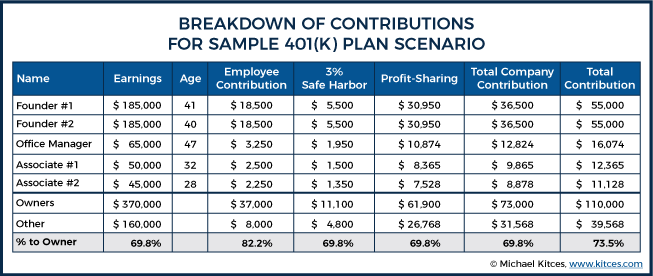
In essence, the 401(k)-with-profit-sharing plan design assumes that the owners will max out their salary deferral component at $18,500, which leaves room for another $36,500 of profit-sharing contributions to get them to the $55,000 Section 415 limit on total contributions that can be made to a defined contribution plan.
Because the owners are already planning on making a 3% safe harbor contribution upfront to all employees, the business must then contribute another 16.73% of payroll in profit-sharing contributions to get the owners up to the maximum limit… and then must make a similar 16.73% profit-sharing contribution to the rest of their employees.
The end result is that the business owners end up contributing $110,000 for themselves between salary deferral, safe harbor, and additional profit sharing contributions, which at their 32% tax rate, saves them $35,200 in taxes. In turn, the company is required to contribute only $31,568 to employees in order to access this tax benefit… which looks compelling, as it means the business owners end up with $110,000 in tax-deferred accounts compounding future growth, and end up with $35,200 - $31,568 = $3,632 of extra cash in their pocket by setting up the plan (more than enough to cover the administrative cost of establishing and maintaining the plan)!
Where Small Business 401(k) Tax Deferral Goes Wrong
While this qualified plan scenario may seem to be a positive for the small business, it will actually reduce the business owners’ wealth in the long term… due to the fact that the business owners have confused tax savings with what is actually “just” tax deferral.
Because the reality is that they didn’t actually eliminate $35,200 in taxes by establishing the 401(k) plan. Those taxes are merely deferred. Someday, the $110,000 will still have to be withdrawn, at which point the $35,200 of taxes will be due. In other words, the “savings” are only temporary. On the other hand, the contributions made to the employees are permanently “lost” as an expense of the business!
Accordingly, the projection below shows the end result of this $110,000 over time, assuming an 8%/year annual growth rate on the 401(k) plan, and that the proceeds are ultimately taxed at 32%... as compared to an alternative scenario where the business just skips the qualified plan, takes the $110,000 of compensation directly, pays the 32% tax rate now, and reinvests the $74,800 of proceeds (assumed to also earn 6.8%/year net of 15% dividend and long-term capital gains rates).
Notably, though, the preceding qualified plan strategy invested $110,000 in the plan and had to spend another $31,568 in (pre-tax) employee contributions to make it work. Which means if the plan wasn’t established, the business owners would have another $21,466 to invest as well, representing the after-tax dollar amount of the contributions that were not made to employees. Thus, had the business owners skipped the qualified plan altogether, they would have had $74,800 + 21,466 = $96,266 available to invest in a taxable account.
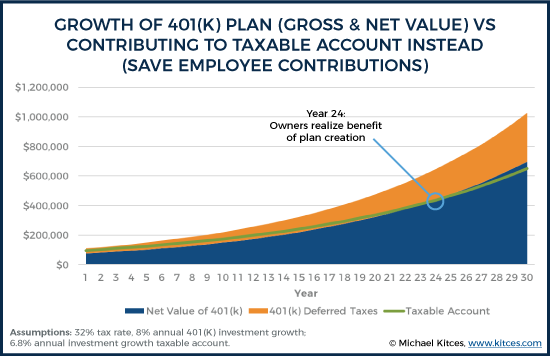
As the results clearly show, not establishing the 401(k) plan actually nets the business owners far more, for decades, than creating the tax-preferenced retirement account in the first place! Even though in the initial year, the establishment of the plan resulted in $3,632 of net cash flow savings! Because the problem, again, is that eventually the deferred tax liability on the 401(k) plan must come due, while the contributions made to employees are permanently gone!
Notably, over time the gap between creating the plan and not creating the plan does narrow, as there is still some value to tax-deferred compounding growth of stocks inside of a qualified plan (versus the investments in the taxable account that were assumed to experience ongoing tax drag). Nonetheless, it takes a whopping 24 years for that value to manifest, and in the meantime the qualified plan scenario continues to lag.
Furthermore, the projection above is based on just a single year of contributions! If we assume the business continues making these same contributions for 5 years, and then projects out the value over the long term, it’s even worse!
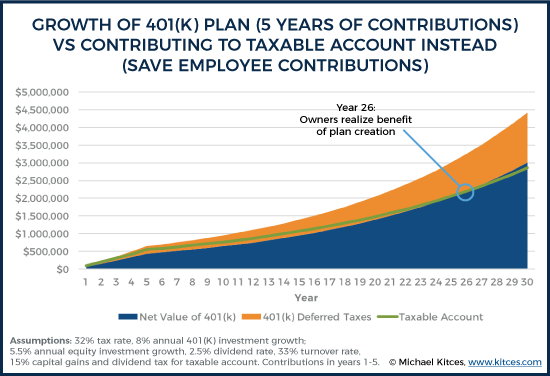
Repeated over time, the hole the business owners dig for themselves paying permanent employee contributions in exchange for only temporary tax savings becomes even deeper, to the tune of more than $120,000, as the cumulative impact adds up over time, and takes 26 years to recover (and by that time the business owners would already be retired!)!
Cross-Tested Profit-Sharing Plans To Skew Contributions To Business Owners
Financial advisors experienced with qualified plan design for small businesses may have noted that in the earlier example, a qualified plan that contributes “only” 69.8% of company contributions to the founders/owners is not necessarily an ideal plan design.
Unfortunately, though, the owners in this example are too young (compared with a non-highly-compensated office manager who is older) to make a small business defined benefit plan or age-weighted profit-sharing plan work, but it would be feasible to at least do a cross-tested profit-sharing plan to further skew contributions towards the highly-compensated owners.
For instance, if the total contributions to owners were going to be 19.73%, a cross-tested plan that separates the (highly-compensated) owners from the (non-highly-compensated) remaining employees would permit employees to receive the lesser of 1/3rd of that amount (6.58%), or 5%, in contributions, which would amount to 5% in contributions, or a mere 2% above the 3% safe harbor contribution already being made.
The end result would be a substantial reduction in the total amount of contributions being made to the non-highly-compensated employees, for a total cost of “just” $8,000 instead of $31,568, while the owners make the same $55,000 in total contributions.
Which would mean a whopping 90.1% of the employer contributions would now be going to the owners/founders! And in the initial year, the business owners would save a whopping $27,200 of cash flow ($35,200 in taxes not paid on the $110,000, reduced by “just” $8,000 of employee contributions).
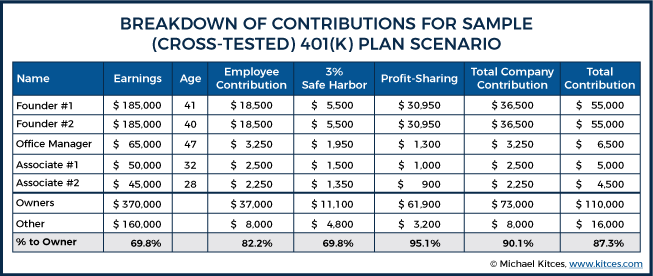
Nonetheless, even with $27,200 of hard dollar cash savings, the reality is that the cash savings still confuse what is upfront tax savings with actually just tax deferral! As the $35,200 of taxes not paid upfront will still have to be paid someday by the business owners! While the $8,000 in employee contributions is a permanently lost expenditure!
Accordingly, if the business owners repeat this strategy for the next 5 years, and then allow the plan to compound, it still takes more than a decade for them to come out ahead, when considering the value of simply keeping their $110,000 of compensation (and $8,000 of employee contributions), pay their 32% tax rate, and reinvest the $80,240 remainder!
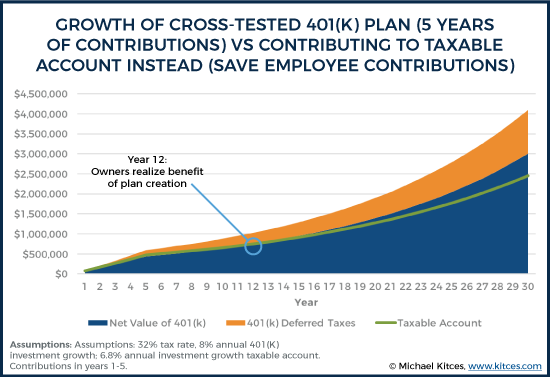
In addition, it’s important to note that this assumes 100% of growth/gain is turned over every year (albeit at 15% capital gains and qualified dividend rates). If the reality is that the taxable account is managed at least somewhat more tax efficiently – for instance, with a 2.5% dividend and “just” 33% turnover – it takes even longer for the cross-tested qualified plan scenario to ever catch up, despite skewing 90.1% of company contributions to the business owners!
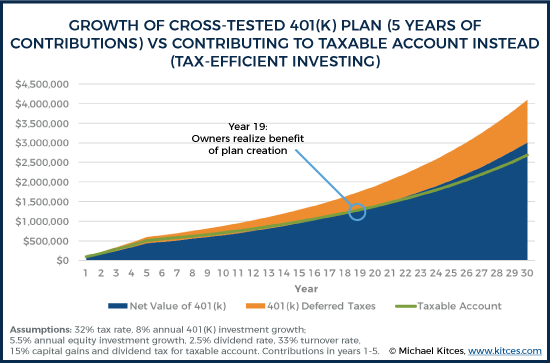
In other words, even in situations where upwards of 90% of the plan contributions go to the owners, the 401(k) plan still doesn’t come out better until the founders would already be on the cusp of retirement nearly 20 years later (as long as they invested reasonably tax efficiently along the way)! Because, again, the value of tax deferral just isn’t that significant compared to a reasonably-tax-managed taxable portfolio. Especially given that this projection ignores small-but-not-trivial ongoing maintenance and administrative costs for the plan as well!
Safe Harbor 401(k) Plans And Making Contributions (Just) To Max Out Salary Deferrals
Given how not favorable it may actually be to make even favorably-skewed-to-owners cross-tested profit-sharing contributions, some business owners may be tempted to fall back on just maxing out the salary deferral component of $18,500, and making what is typically a 3% safe harbor mandatory contribution to employees (in the event that non-highly-compensated employees aren’t contributing enough on their own).
Yet as we’ve seen already, making employee contributions in order for owners to contribute and defer more is not necessarily a winning proposition… both when it comes to profit-sharing contributions, and even safe harbor contributions to ensure being able to contribute up to the $18,500 salary deferral limit!
For instance, continuing the earlier examples, assume the owners decide to simply eschew profit-sharing contributions altogether, and just make their $18,500 salary deferral contribution, along with a 3% safe harbor contribution to all employees (including themselves).
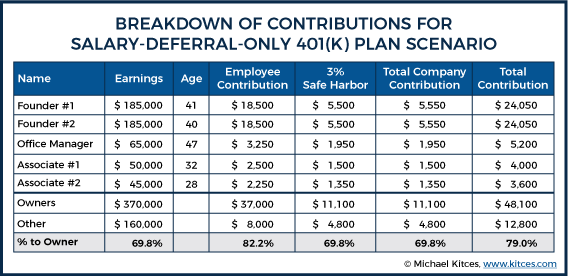
The net result of this scenario is that the two owners are able to contribute a total of $37,000 in salary deferrals, plus $11,100 in their own safe harbor contributions, for a total of $48,100 in contributions. And in exchange, they must make $4,800 in safe harbor contributions to employees (3% of the salary of the Office Manager and Associates).
Yet as we’ve seen earlier, even adding $48,100 of employer contributions in exchange for $4,800 of employee contributions – which means 90.9% of contributions go to owners – is not necessarily enough to make it worthwhile! Especially since the founders could have simply contributed to their own IRAs for up to $5,500 on a pre-tax basis anyway… such that only $37,100 was an actual net increase in pre-tax contributions by creating the 401(k) plan over the available alternative.
And unfortunately, that’s just not enough tax deferral for a cost of $4,800 in employee contributions in the long run!
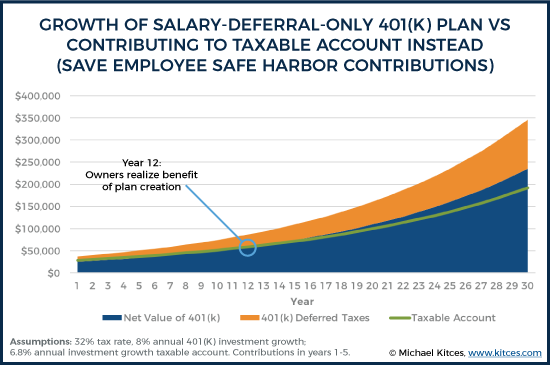
As the results reveal, even “just” making safe harbor contributions to a 401(k) plan to increase the founders’ retirement account contribution limits above the traditional IRA threshold may not be worthwhile after all! (And fare even worse with any level of ongoing 401(k) administrative costs as well!)
Ultimately, the key point here is not that it’s bad for business owners to create 401(k) plans, and to make profit-sharing contributions.
But it is important to recognize that even being able to “skew” contributions 80% to 90%+ towards owners may not be enough to make it financially beneficial on its own in the long run, due to the simple fact that employee contributions are permanent costs, while the cash flow savings of contributing to a 401(k) plan or making profit-sharing contributions are merely tax deferral for the business owners.
Of course, if the business needs to make those contributions to pay a competitive total compensation to employees, or as an employee benefit to attract and retain employees, then it’s simply a cost of doing business and a benefit in and of itself… for which any/all owner contributions are an added benefit. And at least when it comes to profit-sharing contributions (beyond the safe harbor), the employer can also attach a vesting schedule, which creates the potential for non-vested employee contributions to revert back to the plan if there is employee turnover, reducing the net long-term cost of the plan.
Nonetheless, for those who just want to increase employee contributions as a way to increase the tax-deferral benefits for owners (and don’t want to count on high turnover causing unvested employee contributions to revert back)… once the long-term tax deferral (and not true tax savings) impact is considered, it turns out that qualified plans aren’t nearly as compelling as a small business owner tax savings vehicle as commonly believed!
So what do you think? What percentage of contributions must go to owners for a 401(k) with profit sharing plan to be worthwhile? Would you consider not doing a small business retirement plan in light of the long-term cost of employee contributions compared to what are only short-term tax savings for contributions? Please share your thoughts in the comments below!




